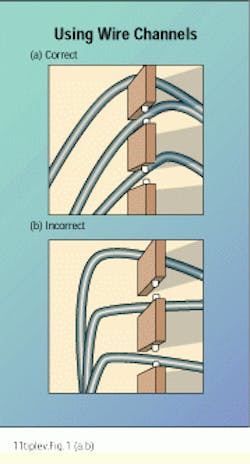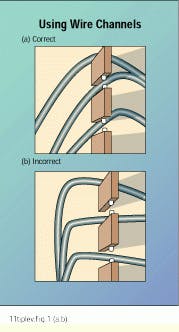Ground rules for rough-in
Don McConaghy, Leviton Telcom
Problem
Too often, wires and cables are pulled and components installed without sufficient forethought and planning. This can result in an installation that is not only unsightly but also difficult to maintain and troubleshoot. In extreme cases, substandard installation practices during rough-in can degrade the performance of the cabling plant.
Solution
Regardless of the type of installation, proper wiring requires careful planning and skilled handling to avoid damaging cables and ensure solid connections. The following are general rules for running cable, whether residential, light industrial or commercial.
Suggestions for rough-in
During rough-in, never put a spliced cable in a wall or in a place where it cannot be accessed.
Lightweight telephone wiring is much easier to damage than nonmetallic cable. The jacket can be caught on sharp edges or nail points, and the conductors inside can be grounded, shorted or broken. It takes just a few minutes to ensure that no connections or splicing were forgotten and that no wiring was damaged as it was pulled in or secured during rough-in.
Do not splice wires on cable runs. Pull a new wire if things go wrong. There are exceptions for residential applications: A single transition from one type of cable to another may be made, and daisy chaining from one outlet to another is permitted in a given room, although this is not the most elegant practice. If necessary, it is permissible to run a new wire from one outlet to the next in a series.
Do not exert more than 25 lbs of pulling tension on 4-pair cables. Larger-capacity cables should be pulled according to the manufacturer`s directions.
Do not bend cable sharply or nick the protective sheath over the insulated wires.
When wiring jacks, correlate the access line number with the pair number--for example, access line one goes to pair one.
To provide compatibility with two-line telephones, wire the two inner pairs of a jack. This leaves the outer pairs of the jack free for other purposes.
If conduit is installed, always leave in a pull cord to facilitate running new wire.
Avoid undercarpet runs if possible, since they are more susceptible to damage. If they must be installed, follow the manufacturer`s directions carefully, and remember that only a single transition from one type of cabling to another is standard in a single room. Avoid installing undercarpet runs in damp areas.
Where possible, use inner walls for runs to avoid penetrating firebreaks and insulation. Inner-wall wiring also makes it easier to replace wires when necessary, or to add wires. When wiring through external walls is not avoidable, handle the installation in the same way you would install electrical wire. Firestopping should also be observed when you penetrate firewalls.
Keep wire away from sources of heat, and avoid glass walls where wires are subject to direct sunlight.
Avoid running external wires--they are undesirable for both aesthetic and safety reasons. Wires on the outside of a building may be permitted by the local building code for additions, but you should avoid them for initial installations.
Leave 18 inches of spare wire at outlets and connection points for connections and changes.
Firestopping, bonding and grounding must be performed according to applicable fire, building and electrical codes.
Do use sweeping bends (a). Do not allow the cable to form right angles or sharp bends (b).
Don McConaghy is an applications engineer at Leviton Telcom, Bothell, WA. This installer tip is excerpted from the company`s recently published book, Installation Strategies for Long Term Cabling System Success.

